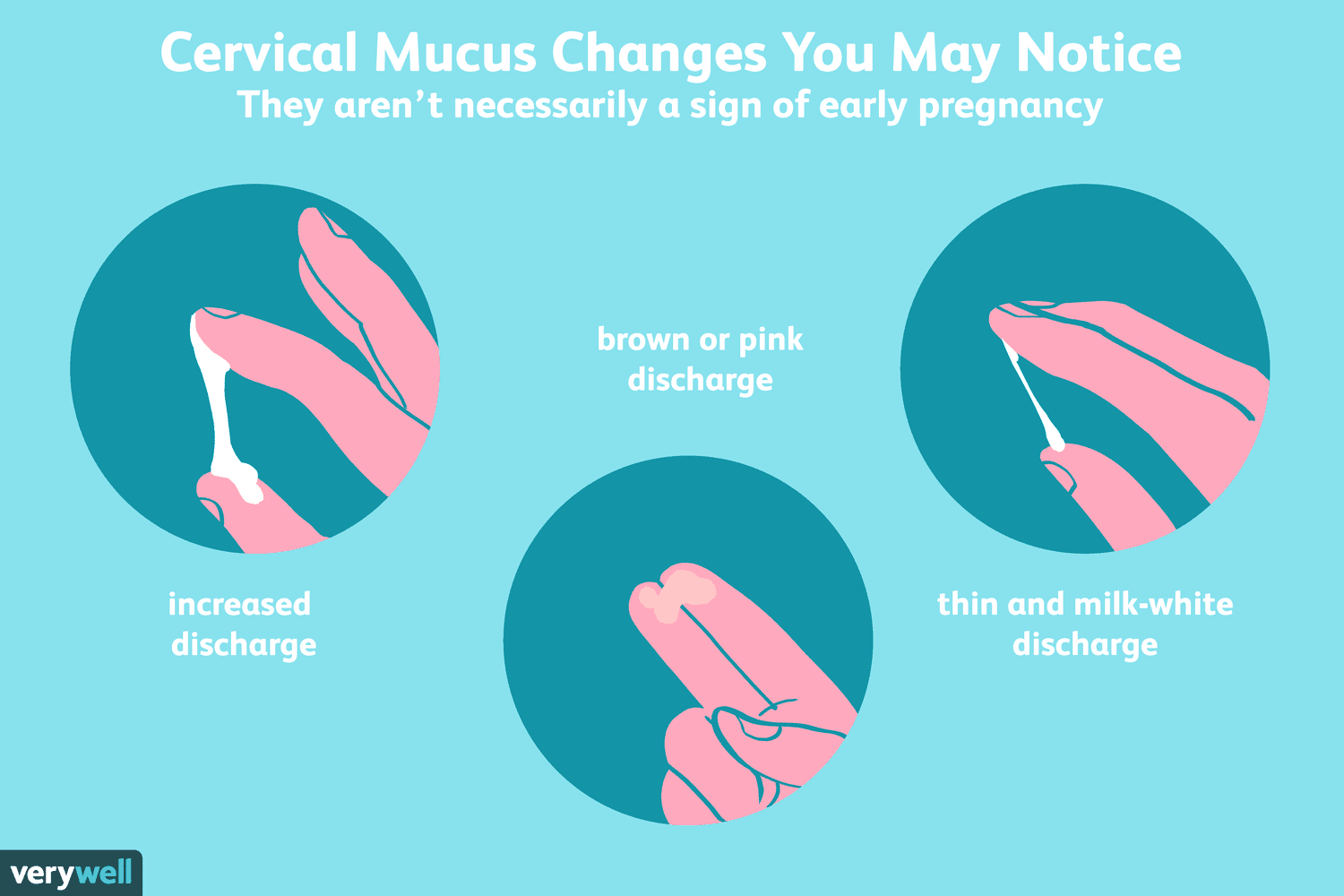A mix of fluid and cells from the vagina that varies from whitish and sticky to clear and watery, possibly associated with an odour.

This mixture is constantly produced by the cells of the vagina and cervix, and it exits the body through the vaginal opening. The composition, amount, and quality of discharge varies between individuals and can vary throughout the menstrual cycle and throughout the stages of sexual and reproductive development.
Vaginal discharge is normal and varies during your menstrual cycle.
Before ovulation (the release of the egg), your body produces up to 30 times more mucous than it does after ovulation. The mucous is also more watery and elastic during that phase of your cycle. You may want to wear panty liners during that time.
A normal vaginal discharge consists of about a teaspoon (4 ml) a day that is white or transparent, thick to thin and odourless. This is formed by the normal bacteria and fluids the vaginal cells create. The discharge can be more noticeable at different times of the month depending on ovulation, menstrual flow, sexual activity and birth control.
• These secretions may turn white or yellow when exposed to the air.
• The amount of mucus produced varies during the menstrual cycle. This happens due to the change in hormone levels in the body.
CAUSES OF VAGINAL DISCHARGE
Things you will learn about
The following factors can increase the amount of normal vaginal discharge:
• Ovulation
• Hormonal imbalance
• Pregnancy
• Sexual excitement
• Menopause
• Forgotten tampon or foreign body. This may cause a foul odor.
• Law estrogens levels
• Less common
Cancer of the vulva, cervix, vagina, uterus, or fallopian tubes
Skin conditions, such as desquamative vaginitis and lichen planus
Different types of infections may cause itching or an abnormal discharge in the vagina.
• Infections spread during sexual contact. These include chlamydia, gonorrhea (GC), and trichomoniasis.
• Vaginal yeast infection, caused by a fungus.
• Normal bacteria that live in the vagina overgrow and cause a gray discharge and fishy odor. This is called bacterial vaginosis (BV). BV is not spread through sexual contact.
DIFFERENT COLOURS OF VAGINAL DISCHARGE
Normal vaginal discharge is milky or white and is odorless. But sometimes, any cause can change color.
1. Thin and clear/watery
This occurs at different times of your cycle and can be particularly heavy after exercising. “Clear or watery discharge is normal,” and if it’s a little cloudy that’s fine too. Depending on where you are in your cycle, the discharge may come out a little thicker, but it’s mostly clear. As long as you’re not having any weird symptoms like itching or any abnormal or unpleasant odour its normal.
2. Stringy or stretchy
This is “fertile” mucous and means you’re ovulating.Around day 14 of your cycle, you may notice a discharge the consistency of egg whites.This is a normal part of your cycle, but heads up — it typically means you’re ovulating (the slippery texture helps sperm swim to the cervix) so if you’re sexually active, now would be a good time to be very careful
3.Thicker than usual
If you’re not having any other symptoms, like a strong odor or itchiness or discomfort down there, it’s probably just normal end-of-cycle creaminess. “Discharge usually increases in thickness during the second half of your cycle,” Dr. Wyckoff says. If everything seems fine otherwise, don’t stress about it.
4. Super heavy
It’s normal to see a little more discharge near the end of your cycle, and if you’re taking hormonal birth control or sexually active, that can make it heavier too. But there are a few other possible causes for the excess moistness like an infection, a lost tampon, or a reaction to a new soap. If it’s bothering you, let your doctor know.
5. Brown or bloody
May happen right after periods as your body is “cleaning out” your vagina. Old blood looks brown.If you just got done with your period, it’s likely leftover blood evacuating the premises. But if you have random mid-month spotting, or this isn’t the first time you’ve noticed blood in the mix, or even if you’re just weirded out by it, talk to your gynecologist — she can help you figure out what might be causing it. “Brownish or blood-tinged vaginal discharge could be from a vaginal infection, a lost tampon, an ovarian cyst, or something within the uterus like a polyp.” None of those are panic-worthy, but you want to get treated ASAP if something’s going on down there.
6. White and clumpy
Thick, white discharge is common at the beginning and end of your cycle. Normal white discharge is not accompanied by itching. If itching is present, thick white discharge may indicate a yeast infection. A thick, white discharge with the texture of cottage cheese is a common symptom of a yeast infection, which occurs when the levels of yeast in your vagina are off balance. Let your doctor know especially if you have other symptoms like an itchy vagina, irritated labia, or pain when you urinate.Yeast infections are easily treated.
8.Yellow or green
May indicate an infection, especially if it’s thick or clumpy like cottage cheese or has a foul odour.Discharge can become slightly discolored when it hits the air, so if you notice some pale yellow discharge in your undies, that’s the most likelyexplanation. But if your discharge is a thick yellow or green, it could be a sign of an infection even a sexually transmitted infection like chlamydia or gonorrhea. If your discharge is green and smells fishy, that could be bacterial vaginosis, which, like a yeast infection, occurs when the bacteria in your vagina is off balance. Either way, your gyno can do a few quick and painless tests to see what’s going on, and bacterial vaginosis is easily treated.
9. Grayish
“A strong, foul, fishy odor with a thin, grayish-white discharge is a classic symptom of a bacterial infection.” Of course, not every odor is caused by an infection.The most common cause of grey vaginal discharge is bacterial vaginosis.
It is not an STD, but rather an infection that can happen when your vaginal pH balance is high or low.
10. Nonexistent
It’s okay if you don’t have any discharge at all everyone’s output is different. “As long as you’re not experiencing any other unusual symptoms, your vagina is completely normal,” Dr. Ross says. And hey, you get to rock white undies without stressing. If the dryness is making you uncomfortable or irritated, though — you guessed it let your gyno know.
So, don’t worry if you have to change your undies twice a day, it’s totally normal. Whether you’re sexually active or not, vaginal discharge happens. Just make sure to keep an eye on the color, smell, and your comfort levels and you should be good to go!
11. Spotting blood
This may occur mid-cycle or when ovulating. Sometimes early in pregnancy you may have spotting or a brownish discharge at the time your period would normally come.
SYMPTOM OF VAGINAL DISCHARGE
• Vaginal itching, burning or irritation
• Thick, white vaginal discharge
• Bad odor that lasts more than a day
• Painful intercourse
• Painful urination
• Pain or tenderness in your lower abdomen (tummy)
• Blisters, bumps or sores in your genital area
How to prevent vaginal discharge?
• It’s normal to have some amount of discharge every day. You can’t prevent it because it’s your body’s way of keeping your vagina clean and healthy.
• Most effective factor is cleanliness and hygiene.Even if you are careful, vaginal infections can occur. You can reduce your chance of infection by doing the following:
• Take a shower or bath regularly using a plain, mild soap or just water. Do not use bubble bath.
• Avoid using vaginal sprays and scented products.
• Use plain white toilet tissue.
• After using the bathroom, always wipe from front to back.
• Wash and dry your hands before touching the vaginal area.
• After intercourse, try to urinate to help prevent a urinary tract infection.
• Use unscented tampons, sanitary pads and liners.
• Change often, at least every 2 to 3 hours.
• Remove the tampon before going to bed and wear a pad instead.
What to wear??
Wear cotton or cotton-lined underpants. Cotton absorbs moisture. It keeps you cooler and drier. Synthetics can trap moisture and cause irritation.
Avoid tight-fitting leggings, tights and pants. They do not let air move.
Avoid sitting around in damp or sweaty clothing.
LIFESTYLE
• A healthy lifestyle helps you fight infections.
• Eat healthy, exercise regularly and get enough sleep.
• Limit the number of sexual partners. Use condoms during intercourse to help prevent sexually transmitted infections.
| ReplyForward |





0 Comments